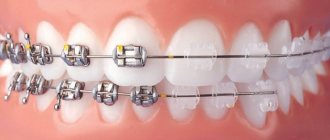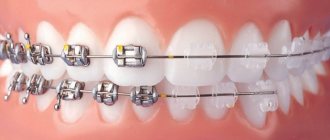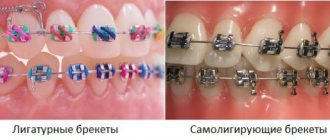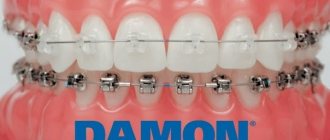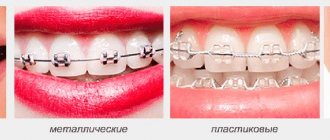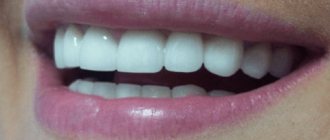Ideally straight teeth and correct bite are an integral feature of every person’s image. It is the smile that contributes to the formation of a positive impression of the opponent. However, not everyone is naturally blessed with straight teeth and a beautiful smile. Often, teeth become significantly crooked, which is a completely natural phenomenon during the development of the body.
Most people naively believe that malocclusion is an exclusively aesthetic defect that you just need to come to terms with. In fact, such problems are completely solvable. Moreover, if you avoid the problem, it can lead to extremely unpleasant consequences. Since the human body is an integral and interconnected system, failures in one area can lead to significant disruptions in another.
Thus, an incorrect bite will contribute to poor chewing of food, which will affect the functioning of the gastrointestinal tract. We recommend that you do not wait for serious consequences to appear, but seek help from a dentist. One of the most optimal treatment options is the installation of ligature braces.
The mechanism of bite correction using braces
Pathologies of occlusion can be congenital, caused by genetic predisposition or abnormalities of intrauterine development, or acquired, caused by bad habits or injuries to the dentofacial apparatus. The use of brace systems in corrective therapy makes it possible to effectively eliminate occlusion defects regardless of the reasons that gave rise to them.
The essence of the mechanism for correcting anomalies is based on the ability of teeth to move from their place under the influence of directed mechanical force. During the treatment process, the bone tissue in which the dental elements are located is thinned in the direction of the movement vector, and a new one is formed in the opposite direction. Thus, the calculated force pressure helps the tooth occupy a new place in the dental row.
The mechanical impact to achieve the goal of corrective therapy is created using bracket systems - non-removable orthodontic structures fixed to the surface of the tooth enamel.
Aesthetic ligature models Ormco
Inspire ICE aesthetic braces are made from artificially grown sapphire. The transparent single crystal is hardly noticeable on the teeth, and the ligature wings and base are stronger than those of the Spirit MB plastic device. Unlike ceramic, sapphire ligature braces look completely transparent.
aesthetic Inspire ICE
Design features of ligature braces
All bracket systems have the same design:
- bracket plates fixed to the teeth using a special adhesive composition;
- a power arc that has “shape memory” (tends to straighten out from a bent position);
- fastening elements that attach the arch to the bracket plates.
If the arch is fixed to the teeth using miniature clips, then such braces are called non-ligating or self-ligating braces. If the arch is attached using ligatures, then such orthodontic structures are called ligature. This is, as they say, a “classic of the genre.”
Either small plastic rings or thin metal wire made of medical steel are used as ligatures.
Plastic ligatures can be of various shades: transparent, silver, colored. Teenagers, as a rule, prefer rich colors. While wearing, the ligatures stretch, so the doctor periodically changes or tightens them.
Note: compliance with the prescribed frequency of visits to the clinic during the correction course is the key to the effectiveness of the process. Otherwise, the result may not be achieved.
Ligature braces are effective in treating both adults and adolescents.
How long should you wear braces?
On average, it takes people at least 1 year to completely correct orthodontic defects. It takes approximately three years to correct even the most severe dental defects. The first results from the treatment can be seen already in the first 1 – 3 months from the moment of wearing. If you want to pre-calculate how long it will take to correct your bite in your particular case, consider the following factors:
- Your age;
- complexity of the defect being corrected;
- general condition of teeth;
- distance between teeth;
- type of construction (lingual/vestibular, ligature/non-ligature, metal/sapphire, etc.)
Types of ligature systems
The main classification of braces is carried out depending on their positioning:
- those fixed on the outer side of the dental row are called vestibular;
- attached to the inner surface - lingual.
The material used to make orthodontic products also affects the type of bracket system:
- metal – bracket plates are made of a hypoallergenic metal alloy (cobalt, nickel or gold). Such designs are very reliable, efficient, affordable in cost, but their appearance is not aesthetically pleasing;
- ceramic - made of high-strength ceramics. Their color practically matches the shade of natural tooth enamel, so they have a high level of aesthetics. Cannot be used if excessive force pressure must be applied to correct defects (i.e., to correct severe pathologies). The price of such systems is significantly higher than similar metal products.
How braces work
Any braces system works on the same principle. The design, through simple manipulations, puts some pressure on the crooked teeth, thereby gradually returning them to the desired position. The designs of such systems may differ slightly, but this does not in any way affect the general standards of their operation.
A bracket is a small plate that is attached to the surface of the teeth either from the outside or from the inside. These plates, in turn, are attached to a special wire, which tends to return to its original shape. Consequently, when such a system is fixed on the teeth, the wire will begin to gradually straighten, thereby correcting the position of the teeth.
A metal arc can be attached in various ways, but the result will always be the same.
Indications and contraindications for installation
Any type of treatment should be prescribed exclusively by a specialist. Therefore, identifying indications and contraindications for correcting occlusion defects is a priority step, without which corrective therapy cannot be started.
Indications:
- Incorrect position of the jaws or individual teeth
- Tremas and diastemas (large distances between dental elements)
- Crowding of dental units
- Deep or crossbite
Contraindications:
- Periodontitis and periodontal disease
- Endocrine pathologies
- Severe cardiovascular diseases
- HIV;
- Tuberculosis
- Bone diseases (osteoporosis, osteomyelitis)
- Bleeding disorder
- Edentia (absence of many teeth)
- Oncology
- Mental illness
Important: An orthodontist identifies indications for starting corrective therapy with braces only after conducting a thorough hardware diagnosis. This is necessary to develop an adequate detailed treatment plan.
Aesthetic system without ligatures - what is it?
It is widely believed that non-ligature braces are a type of aesthetic system. In fact, this is only partly true.
Aesthetic self-ligating braces include ceramic and sapphire designs. Metal ones, although they look more attractive than ligature systems due to small locks, can hardly be called aesthetic. They look neat, but are much more noticeable than designs made of ceramics and artificial sapphires.
Also, aesthetic non-ligature braces include lingual systems - they are attached to the “lingual”, inner surface of the teeth. Such designs are invisible and are often chosen by public people.
The only drawback of non-ligature aesthetic systems is their high price. In order to reduce it, dentists combine materials: in the frontal zone, sapphire or ceramic clasps are fixed on the upper teeth, and metal ones on the lower jaw, chewing teeth.
Stages of corrective therapy
Correcting anomalies of the dental system is a long and painstaking process consisting of several stages:
- visual and hardware diagnostics: computed tomography, teleradiography,
- rendering a verdict, making a diagnosis, determining indications and contraindications;
- development of a treatment plan;
- oral hygiene: treatment of teeth and gums, professional cleaning;
- taking individual measurements (casts or scanning), making a model, drawing up an estimate;
- production of braces;
- installation of a brace system for a patient;
- wearing the device with periodic system adjustments. The duration depends on the severity of the specific clinical case and is determined by the orthodontist;
- removal of braces and installation of a removable or non-removable retainer. The duration of retention also depends on the individual characteristics of the clinical case.
Specialist comment: the retention stage is very important for consolidating the achieved results. Failure to follow the recommendations of the attending orthodontist may invalidate the results of therapy, and everything will return to its previous position.
Pros and cons of non-ligature systems
Many orthodontists and patients choose self-ligating appliances, which take up minimal space on the crown of the tooth, which greatly affects the appearance. The main positive qualities of braces systems:
- Designs without ligatures are made of ceramics, plastic and artificially grown sapphire, which makes the device an aesthetic accessory, and not just a forced vestibular product that spoils the appearance.
- The movement of teeth is carried out gradually, with the same force applied.
- The sliding of the arch in the grooves occurs more smoothly due to the smooth polished surface of the bracket.
- Braces without ligature systems bring less discomfort to patients and cause less severe pain.
- The need for frequent visits to the orthodontist is minimized; consultation can usually be done in 8-12 weeks.
- One of the most popular no-ligation systems is Damon, an American design characterized by a beautiful, modern design and comfortable wearing.
In some cases of simple pathologies, devices without ligatures can quickly correct the position of teeth. It is also possible to use them at the final stage of treatment - to consolidate the result obtained from the metal ligature structure. Materials for non-ligature products are resistant to staining with natural food dyes, which is an additional advantage.
Small disadvantages of products without ligatures:
- With their help, significant defects and abnormalities in the development of the jaw cannot be corrected.
- Less force when straightening teeth than in classic ligature devices.
- A high price, which is not always justified as a result of treatment.
- The effectiveness of the application depends on the qualifications of the orthodontist - even braces cannot always correct the bite.
Before using fixed orthodontic appliances, doctors often carry out preparations, which sometimes include removing a healthy tooth. This is necessary to create a free space, which is gradually filled by other teeth in the long process of alignment. Before installing a ligature-free structure, such preparation is not always carried out.
Installation of ligature bracket system
The procedure for fixing the device takes about one and a half hours. What does the doctor do:
- washes the enamel, then thoroughly etches it with a special substance designed for better adhesion of the bracket plates to the surface of the enamel;
- applies an adhesive composition to the areas of future fixation of the plates;
- glues the plates and removes excess adhesive solution;
- threads a power arc into the grooves of the bracket plates;
- fixes the arch with ligatures.
How often do you visit a doctor?
Treatment with ligature structures usually lasts from one and a half to three years.
To replace arches and ligatures, patients with classical systems visit an orthodontist every month. The doctor removes the ligatures, changes the archwires and puts on new elastic rings or fixes a metal wire on each bracket. The procedure takes from 20 to 35 minutes. Patients wear self-ligating devices for an average of one to two and a half years. The doctor makes an appointment once every two months and spends 15 to 25 minutes on the patient. Using a special SpinTek tool, the orthodontist opens the bracket cover and changes the arches.
positioning of the Damon Clear self-ligating bracket
Features of the adaptation period
The patient should be prepared to experience discomfort for several days or weeks (depending on the threshold of sensitivity):
- rubbing of the mucous membranes of the lips and cheeks;
- violation of diction;
- discomfort when eating.
Expert advice for minimizing discomfort:
- to prevent chafing, you can use special wax (sold in pharmacies);
- for minor pain, you should rinse your mouth 3-4 times a day with saline solution (1 tsp per glass of warm water). The procedure cannot be performed if there are wounds and abrasions in the mouth. In this case, it is better to use a soda solution in the same concentration;
- In case of severe pain, you need to take a tablet of any painkiller. Note: strictly follow the dosage indicated in the instructions for the medicine;
- In the first days after installing braces, cancel intense physical training. Yoga exercises will help during this period;
- learn to chop food with a knife, exclude excessively hard or sticky foods (dried, dried) from your diet. During the first few days, the products can be ground in a blender.
Attention: if the pain is severe and does not go away within several days, then you should definitely consult your doctor.
What braces should I put on an adult?
For people over 30 years of age, the doctor selects an orthodontic device taking into account aesthetic requirements, functionality and cost. Since skeletal growth has already stopped, making the right choice is more difficult.
If you want to correct the position of your teeth as an adult, you should choose non-ligature products. It is better to choose ceramic, silicone or sapphire models because they are similar to the color of natural enamel. Silicone aligners are placed when there is a slight change in the bite.
Based on the installation method, people over 30 years of age choose a hidden mount. Lingual appliances are attached to the inside of the teeth. They are visually invisible, do not interfere with diction, and do not injure the mucous membrane. This fact is an advantage, because the treatment period in adults increases by 6-12 months, and most adults are embarrassed to wear the structure. Often the material is selected based on price. Prices for metal structures for one jaw start from 30 thousand. Sapphire and ceramic models are more expensive. Their prices are 50 thousand and 40 thousand respectively.
Hygienic care
The bracket design has many areas that are very difficult to clean from food debris and plaque. Therefore, hygienic care for them requires special attention and patience. Special devices are used for cleaning (in addition to a regular toothbrush and paste):
- V-shaped brushes;
- brushes of different sizes and bristle angles;
- dental floss (floss);
- irrigator is a device for cleaning hard-to-reach places between teeth and orthodontic elements. The principle of operation is based on the controlled supply of a stream of water (or solution) under pressure.
You should clean your mouth while wearing braces twice a day. Ideally, after every meal. But, if this is not possible, then you need to rinse your mouth thoroughly after eating.
How to properly care for ligature braces so that the dream of perfect teeth becomes a reality?
The care is basic, but the outcome of treatment depends on compliance with these rules:
- the patient must have a minimum set of care products (special brush, irrigator, brushes, rinses, paste);
- brush your teeth not only in the morning and in the evening, but also every time after eating - it is important to thoroughly clean out leftover food, because it is they that provoke the formation of pathogenic flora. When wearing braces, it is important to maintain healthy teeth so as not to have to deal with the treatment of caries and pulpitis;
- In case of any defect in the braces system (if the arch has come off, the lock has come loose, the ligature is damaged, etc.), you must contact your dentist. Under no circumstances should you do this yourself.
Diet restrictions
To prevent braces from breaking or changing the vector of force, you need to reconsider your diet. Orthodontists recommend:
- hard vegetables and fruits must be grated or crushed in a brander before use;
- You cannot bite seeds, chew gum, eat nuts, dried apricots and other dried fruits;
- Avoid consuming very hot or extremely cold foods and drinks;
- limit the intake of food and drinks containing artificial or natural colors (tea, coffee, red wine, soda, berries, etc.).
Important: failure to follow the recommendations given by a specialist may result in system failure. In this case, the device will need to be repaired, which will lead to an increase in the correction period and an increase in the cost of treatment.
Diet while wearing braces
The main rule for all patients is strict compliance with the doctor’s requirements. Even the most durable metal structures will not be able to withstand the consumption of solid foods, not to mention ceramics. Regardless of the type of design used, care must always be taken.
To prevent the possibility of damage to the braces, experts recommend refraining from consuming the following foods:
- Firm fruits and vegetables. This includes apples, pears, carrots, nuts and much more. Solid foods can damage the structure of the braces, which will undermine the entire treatment process.
- Chewing gum and other products with a viscous consistency. Such food products will simply get stuck in the brace system.
- Foods and drinks that are too hot or cold. In case of sudden temperature changes, the bracket arch can be significantly damaged.
- Products containing dyes. Here, the possibility of damage to the structure itself is excluded, but the appearance of the product will be spoiled. This especially applies to plastic elements. You should refrain not only from food with dyes, but also from smoking.
If you are careful, the structure will remain intact throughout the entire treatment process.
Vestibular and lingual apparatus
Orthodontists install braces in the oral cavity in two ways: on the vestibular (visible) and lingual (in contact with the tongue) side of the dentition. With the lingual type of fixation, aesthetic indicators are higher, but the period of adaptation to internal braces is more difficult. Patients with lingual devices do not experience psychological discomfort: the devices are almost invisible to others. The cost of invisible structures is higher compared to traditional vestibular systems.
lingual braces STb
Popular brands
Our clinics use only the most effective ligature and non-ligature brace systems, which have received a positive recommendation from specialists and patients. Here are some of them:
- metal ligatures Victory, Biomim;
- ceramic ligatures Advanced, Hype;
- self-ligating metal DamonQ, H4;
- self-ligating ceramic Damon Clear;
- self-ligating lingual WIN and INCOGNITO.
The network of Moscow aesthetic dentistry centers “Smile” offers reasonable prices for orthodontic therapy, the opportunity to pay for braces in installments and without interest, and a family discount. Our specialists have higher basic education and regularly improve their professional level by undergoing training in leading Russian and European orthodontic clinics. We provide our patients with treatment that meets international standards.
Our branches are located within convenient transport accessibility:
- in the district of Art. m. Alekseevskaya (VDNH district and Mira Ave.), st. 3rd Mytishchinskaya 3, building 2;
- in the district of Art. m. Shelepikha, Shelepikhinskaya embankment, 34, building 1.
Our orthodontists will make your smile beautiful! We are waiting for you!
